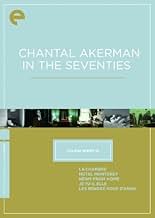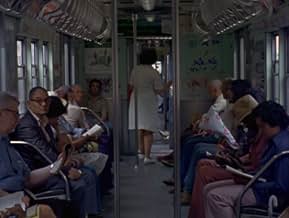Imágenes impersonales pero bellas de la vida de Chantal Akerman en Nueva York, complementadas por cartas de su querida pero manipuladora madre, leídas por la misma Akerman.Imágenes impersonales pero bellas de la vida de Chantal Akerman en Nueva York, complementadas por cartas de su querida pero manipuladora madre, leídas por la misma Akerman.Imágenes impersonales pero bellas de la vida de Chantal Akerman en Nueva York, complementadas por cartas de su querida pero manipuladora madre, leídas por la misma Akerman.
- Dirección
- Guionista
- Elenco
- Dirección
- Guionista
- Todo el elenco y el equipo
- Producción, taquilla y más en IMDbPro
Opiniones destacadas
Chantal's camera records all this squalor in exquisite, non-judgmental long takes. You can almost smell the place. Somehow, the city arranges itself for her in fascinating compositions of color, personalities, and activities. What's that guy over there doing? What is that woman thinking about?
In counterpoint to the visuals, Chantal reads irritating letters from her beloved mother complaining that Chantel does not write frequently enough and When is she coming home? But how could she come home when there is such rich, baroque subject matter for her camera? We know that after her mother died several years later, Chantal committed suicide. The tension between her mother's letters and the power of the city is palpable.
Chantal has left us this gift of a precise record of a time and place that existed once and will not exist again. The final extremely long shot, taken evidently from the Staten Island ferry, is of Manhattan with its Twin Towers still present slowly receding and disappearing in the mist.
"News From Home" gives you that chance. It isn't a movie for the average viewer, or even the average museum goer. It's introspective, spellbinding and gorgeous, given a chance. I loaned it to a friend and suggested he "let yourself go" while watching it, and he reported "it turned into magic once I let it flow through me."
If you want things that blow up, swear words, and sex, you are in the way wrong place sister. This is one of the best art films I have ever seen, without all that inaccesible interiority of so many other "art" film makers.
It's more like a personal documentary, which sounds impossible to pull off doesn't it? Well, Derek Jarman's "Blue" pales to this private gallery of scenery and emotion, which makes "News" far advanced, cuz "Blue" is my fave of his.
On one hand is the massive city, New York before the makeover in all its brownstone squalor and sleepy routine. The whole film is a series of languid pans of the camera, they capture people waiting in subway stations, a black woman sitting outside on a chair, kids playing in a fire hydrant, street views and Bronx projects, coming and going. If like me, you're drawn to films that wander, you'll be exhilarated to see this.
On the other we have letters that Akerman's mother sent to her while she was in New York as a young girl, she reads these to us in quiet voice-over. She has such a soothing, calm voice. A mother who worries like all mothers do, who wants to know how she's doing, complains that she never writes back, tells about her health and how the store is doing and who got married to whom and that the heat is making her listless.
It's a quietly captivating thing, all in the contrast of exchange between a city that is cold and nameless, vast, and a glad voice from a faraway home that whispers news, love and worries. At one point the engine noise of cars in a four-lane boulevard drowns out a letter being read.
It swims from loneliness to familiarity, because it's all a part of it. And I'm reminded again of how I love seeing America through European eyes. I rank it up there with Varda's Documenteur (it's LA there) as views I'll carry with me, another Belgian, another spirit that wanders freely.
It ends with a long unbroken shot of Manhattan from a ferry vanishing in the distance with seagulls flying overhead. Forget about 'experimental' and 'minimalism', the shots being geometric or not; that's just the brush. A summer was lived.
¿Sabías que…?
- TriviaWhen Akerman's mother writes her father lost 300,000 francs due to a client's bankruptcy, that would equate to about $8,300 at the time or $38,100 in 2019.
- Citas
Herself - Letter Reader: I received your screenplay. It's well-written, but you know my taste: I find it sad and gloomy. Those people sure have a hard life. It's an important social issue. I hope it will turn out well. The public must be made aware of all this suffering that you young people see so clearly.
- ConexionesFeatured in What to Watch: Cate Blanchett's Films of Hope (2020)
Selecciones populares
- How long is News from Home?Con tecnología de Alexa
Detalles
- Fecha de lanzamiento
- Países de origen
- Idioma
- También se conoce como
- News from Home
- Locaciones de filmación
- Veselka Restaurant, 144 2nd Ave, Nueva York, Nueva York, Estados Unidos(newstand outside with awning in Ukrainian)
- Productoras
- Ver más créditos de la compañía en IMDbPro
- Tiempo de ejecución
- 1h 29min(89 min)
- Mezcla de sonido
- Relación de aspecto
- 1.37 : 1






















